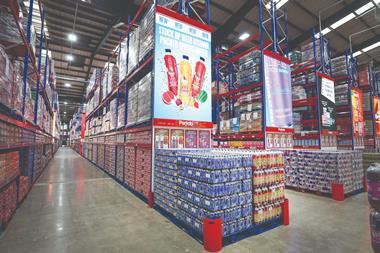Many independents claim they are saving energy and cash by fitting doors to their chillers. So why isn’t everyone as open to chiller doors? Elinor Zuke reports
Even in the height of summer, customers’ teeth used to chatter in the aisles of Andrew Thornton’s Crouch End Budgens. Not any more. Now, the climate’s far more temperate, thanks to the doors Thornton fitted to his chiller cabinets.
The chiller doors have been a game-changer for the business. In addition to making the store environment more pleasant, Thornton reckons he will cut his carbon emissions by 4.8 tonnes the carbon equivalent of taking the Eurostar to Brussels 262 times. The doors have also beefed up the bottom line, with the energy savings leaving him £744 a month better off.
The business case for chiller doors is clearly compelling. Yet so far, Thornton is very much in the minority. Even among the big four, only Tesco has started to install them. The next year could, however, mark a tipping point, with c-stores and independents very much leading the way.
They already have a head start on their bigger rivals. Spar wholesaler and retailer James Hall was the first to give chiller doors a go at its company-owned stores. Its Padiham store cut the company’s annual electricity bill from £4,416 to £1,350.50. And with installation costing £3,450, investment was recouped in just over a year. “The saving is equivalent to an extra £10,000 pounds of sales at 30% margin,” claims Frank Frayling, James Hall’s store design & technical services manager.
It’s no surprise, given these pretty much instant results, that it’s now full steam ahead at Hall. More than 15 company-owned stores currently have doors, with that set to rise to 45 by the end of the year.
Hall isn’t the only one to have seen the light. The independent Spar retailers the wholesaler delivers to are also expressing an interest, says Frayling. “Since Padiham, we’ve had huge uptake 70 independents will have chiller doors by Christmas.”
Crucially, the doors had no impact whatsoever on sales, according to Frayling. This is the major concern expressed by retailers but Frayling isn’t the only one to report no adverse impact. Jonathan James, too, claims he hasn’t had any drop in trade or received a single negative comment about the doors in two of his forecourts.
“The key thing is getting the message out about why you’re doing it,” says James. “All my doors have signs about how they save more energy than three houses use in one year or making 144,000 cups of tea.”
He’s hopeful that more UK retailers will wake up to the benefits of chiller doors, which are already commonplace in the US. The backing of Tesco can only help in this regard. The company has installed chiller doors in 350 Express and Metro stores since February 2009 and pledged to put them into all new c-stores. They are also in its zero carbon superstores in Ramsey, Bourne and Welshpool. Tesco says the doors can save up to 25 tonnes of CO2 each year per Express store and help maintain comfortable temperatures for shoppers.
According to Bruce Johnson, manager of a carbon-neutral Tesco Express in Hinckley, chiller doors are a no brainer. “I’ve managed a store where everything else is comparable and for whatever reason the profitability of this store is 50% to 60% higher.”
Despite Tesco’s endorsement, the rest of the big four are circumspect to say the least. “We’ve tried doors on chillers the customers don’t like them,” claimed Sainsbury’s CEO Justin King at an environmental debate in May, adding: “If they’re being opened wide every 20 to 30 seconds, they’re not actually saving that much energy.”
Morrisons gives chiller doors a similarly frosty reception, saying they would be a “major inconvenience” to customers and not suit the layout of its stores. “The current measures we employ, such as curtains, allow the units to be kept cool efficiently,” says a spokesman. And Asda after trials of chiller doors two years ago has gone decidedly quiet on the matter, declining to comment.
Thankfully, the reluctance of the mults to embrace chiller doors hasn’t put off those in the independent c-store sector. Delta Refrigeration has been doing a roaring trade this year retro-fitting doors to Musgrave retailers and other Spar stores. “All stores are concerned about their energy costs, whether it’s Mr Patel’s Londis shop in London or a Southern Co-operative,” says director Simon Robinson. “It’s growing by word of mouth one installation typically leads to six enquiries.”
Attitudes are thawing, but James believes the crunch time for chiller doors is fast approaching. “It’s that Betamax-VHS moment where people decide whether to go down one route or not,” he says. “If everyone follows, it will become the norm.”
With Tesco this week confirming trials at two superstores, Betamax’s stock just improved.
The chiller door debate
FOR:
“The saving is equivalent to £10,000 of sales at a 30% margin” James Hall
“The energy use is on average 50% lower than open-fronted fridges” Tesco
AGAINST:
“Fitting them would be a challenge. They’d be a major inconvenience to our customers” Morrisons
“If they’re being opened wide every 30 seconds, they’re not actually saving that much money” Sainsbury’s



















No comments yet